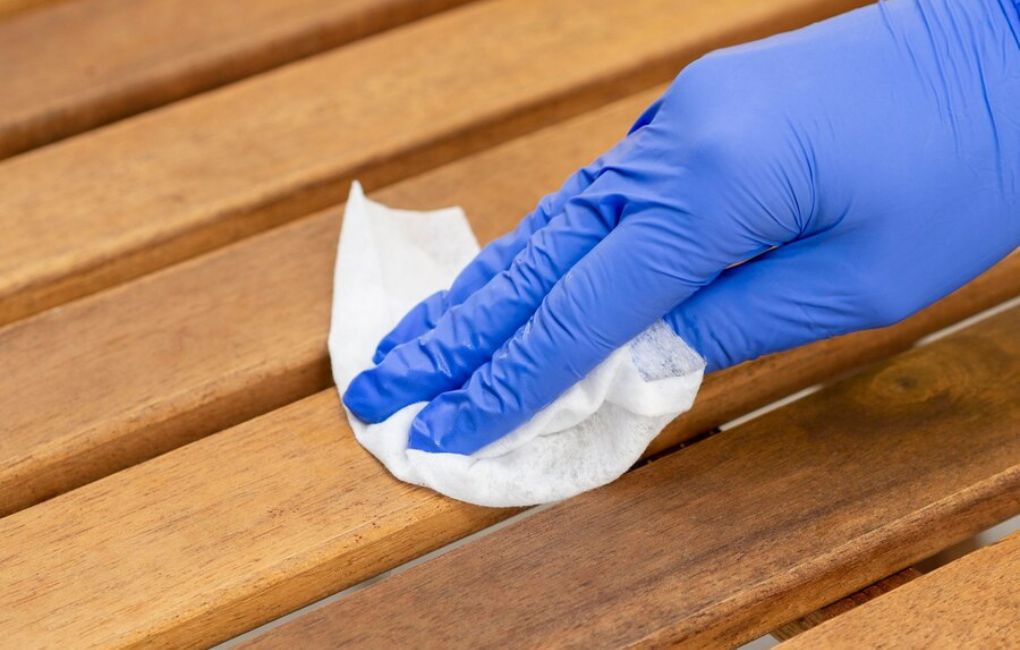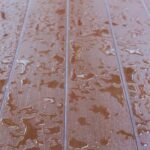Water is a big problem for wooden floors because it can cause them to change shape, become uneven, and expand. Whether you spill something on your hardwood floors, have had a flood, or suspect moisture under laminate flooring, it’s important to deal with it immediately. Moisture underneath hardwood floors can harm them and make them not last as long. If you don’t handle spills and flooding quickly, you might need to fix or replace your floors soon. Ignoring spills and moisture can also lead to mold growing under the hardwood, which can make it hard to breathe and cause other lung problems. So, it’s crucial to take care of any water issues under your wooden floors quickly.
Causes of Moisture Under Wood Floor
Moisture can accumulate under wood floors due to various reasons:
Spills and Leaks
Accidental spills or leaks from plumbing fixtures, appliances, or roofing can lead to moisture accumulation underneath wood flooring. These leaks can seep through gaps or cracks in the floor, causing the wood to absorb the moisture and potentially swell or warp. If left unaddressed, this moisture can create an environment conducive to mold growth and compromise the structural integrity of the flooring.
High Humidity
High humidity levels in poorly ventilated areas like basements or crawl spaces can lead to moisture buildup under wood floors. The moisture in the air can permeate through the flooring material, causing it to absorb and retain water. Without adequate ventilation to allow for proper airflow and moisture evaporation, the trapped moisture can accumulate, potentially causing the wood to swell, warp, or develop mold over time.
Flooding
Flooding from natural disasters, burst pipes, or overflowing appliances can quickly saturate the area beneath wood floors. Without prompt intervention, the water can seep into the flooring material, causing it to swell, buckle, or warp. Additionally, prolonged exposure to moisture can promote mold growth, posing health risks and potentially necessitating extensive repairs or replacements.
Groundwater Seepage
In areas with high groundwater levels or inadequate drainage, water can infiltrate through the foundation or concrete slab beneath wood floors. This seepage can gradually saturate the ground underneath, resulting in moisture issues for the wood flooring above. Over time, the trapped moisture may cause the wood to swell, warp, or decay, necessitating remediation efforts to prevent structural damage and mold growth.
Condensation
Condensation occurs when warm, moist air comes into contact with cooler surfaces, which leads to water droplets forming on the surface. In humid environments, this temperature difference between the air and the floor surface can cause condensation to form underneath wood floors. Over time, the accumulated moisture can penetrate the wood, potentially causing damage such as swelling or mold growth.
Signs of Water Damage to Wood Floors
Deciding whether to repair or replace water-damaged wood flooring depends on several factors. To assist in making this decision, here are common signs of water damage on hardwood floors in your home.
Cupping
Cupping in wood flooring appears as concave indentations running across the width of the floorboards, with the edges raised higher than the center. This deformation occurs when moisture is absorbed by the bottom of the boards, causing them to swell and buckle. Depending on the extent of cupping, repairs such as sanding and refinishing may be sufficient, while severe cases might necessitate replacement of the affected boards to restore the floor’s integrity and appearance. Addressing the underlying moisture issue is crucial to prevent further damage and maintain the condition of the wood flooring.
Crowning
This describes an area where floorboards have been pushed together, often due to absorbing too much moisture. Sometimes, this causes the affected boards to appear raised, forming a bumpy or mound-like effect on the floor. Unfortunately, crowning typically signals prolonged water exposure and might necessitate replacing the affected floorboards or even the entire floor to address the issue properly.
Buckling
Warped, lifted, or distorted floorboards indicate significant water damage, typically resulting in buckling. This occurs when moisture infiltrates the subfloor, causing the boards to expand and distort. In cases of buckling, it’s often necessary to replace the damaged sections or even the entire floor to restore its integrity and appearance.
Staining
Stains or discoloration on the wood surface are indicative of potential water damage. If the stains haven’t deeply penetrated the wood fibers, there may be a chance to refinish or repair the affected areas. However, deep stains that have compromised the integrity of the floor will likely necessitate complete replacement. Assessing the depth and extent of the stains is crucial in determining the appropriate course of action to restore the floor’s appearance and structural integrity effectively.
How to Draw Moisture Out of Wood Floors?
To prevent irreparable damage to your hardwood floors, follow these steps to how to remove moisture from floor:
Supplies You Need
- Towels
- Wet vacuum
- Disinfectant cleaner
- Dehumidifier
Remove Damp Items from the Floor
Wet rugs and furniture can continuously release water onto your wood flooring, potentially causing further damage. Additionally, damp items create an environment conducive to mold and mildew growth, which can penetrate the hardwood seams. To prevent future harm, it’s crucial to quickly remove all wet objects from the floor. This action not only mitigates ongoing water exposure but also helps safeguard against mold and mildew development and preserve the integrity of your hardwood flooring.
Extract as Much Moisture as You Can from the Affected Area
When encountering a small spill, many homeowners opt for towels or rags, which suffice for minor incidents. However, for larger spills that saturate wood floors, employing a wet vacuum is necessary to effectively extract excess moisture. Utilize the wet vacuum until the canister shows no further signs of water, ensuring thorough removal of moisture from the flooring. This proactive approach helps prevent water damage and potential issues like warping or mold growth.
Thoroughly Clean the Wood Floor Surface
Dirt and debris accumulation on hardwood floors can retain moisture and harbor bacteria, posing potential risks to both the flooring and occupants’ health. To effectively sanitize and clean the surface, utilize a disinfectant cleaner to remove any contaminants thoroughly. Once the surface is free from dirt and debris, employing a wet vacuum can further eliminate residual moisture, ensuring the wood flooring is thoroughly cleaned and sanitized. This comprehensive cleaning approach helps maintain the integrity of the hardwood while minimizing the risk of bacterial growth and moisture-related issues.
Dry the Flooring
Despite appearances, moisture may still be present beneath the surface of your hardwood floor, seeping into cracks and crevices. Utilizing a dehumidifier is an effective method to extract residual moisture from the wood flooring. Set the dehumidifier to its highest setting and position it centrally within the room for a minimum of 24 hours. This process aids in thoroughly drying the wood, reducing the risk of long-term damage and mold growth, and ensuring the longevity of your hardwood flooring.
Check for Mold Growth
Mold presents significant health hazards to households and should be immediately addressed. Conduct a thorough inspection of your floors for any signs of mold or mildew growth. If you notice visible mold spores or detect musty odors, it’s essential to contact professionals immediately. They can assess the extent of the mold problem, implement appropriate remediation measures, and ensure the safety of your household.
Should You Fix It or Get New Wood Floors?
Deciding whether to repair or replace your wooden floor depends on various factors. If the damage is minimal, such as small scratches or localized discoloration, repairs may suffice. However, extensive issues like widespread water damage, severe warping, or deep staining may necessitate replacement. Generally, if the structural integrity of the floor is compromised or if repairs would be costly and ineffective, replacement is the best option.
It’s crucial to seek professional guidance, such as water restoration services in Denton County, to accurately assess the damage and determine the most suitable course of action. Professionals can provide expert advice on whether to repair or replace your wooden floor, ensuring optimal outcomes and preserving the beauty and functionality of your home’s flooring.
FAQs
How to dry a floor after mopping?
After mopping, ensure efficient drying by using a clean, dry mop or towel to remove excess moisture. Open windows or turn on fans to promote air circulation and expedite drying.
How to dry a floor quickly?
To quickly dry a floor, use a combination of towels and a fan to absorb and evaporate moisture efficiently. Ensure good ventilation to accelerate the drying process.
How do you dry a wet bathroom floor fast?
To dry a wet bathroom floor quickly, use a mop or towels to soak up excess water, then open windows or turn on a fan to promote air circulation and quicken drying. Alternatively, use a hairdryer on a low setting to evaporate the remaining moisture.
Do floors dry on their own?
Floors can dry on their own over time, but the speed of drying depends on factors like humidity, airflow, and the type of flooring.
Conclusion
While water spills on hardwood floors can cause warping and permanent damage, quick action can help minimize harm. The key is to remove any standing water as soon as possible. Blot the area with clean cloths or a wet vac to absorb moisture. For lingering dampness, use fans and a dehumidifier to promote drying. If the spill was significant, monitor the floor for warping or discoloration. If these signs appear, consult a professional for repairs to prevent further water on hardwood floors damage.






